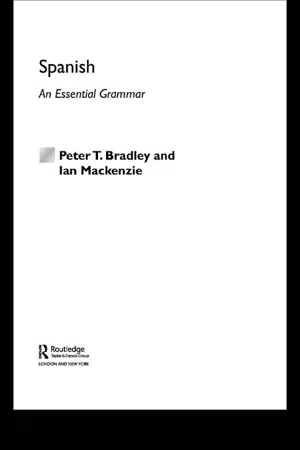
- 352 pages
- English
- ePUB (mobile friendly)
- Available on iOS & Android
Spanish: An Essential Grammar
About this book
Spanish: An Essential Grammar is a concise and user-friendly reference guide to the most important aspects of Spanish.
It presents a fresh and accessible description of the language that combines traditional and function-based grammar. The book sets out the complexities of Spanish in short, readable sections, and explanations are clear and free from jargon.
The Grammar is the ideal reference source for the learner and user of Spanish. It is suitable for either independent study or for students in schools, colleges, universities and adult classes of all types.
Features include:
* clear distinctions between the essential and basic aspects of Spanish grammar and those that are more complex
* full use of authentic examples
* easy to understand explanations of areas that customarily pose problems for English speakers
* detailed contents list and index for easy access to information.
Frequently asked questions
- Essential is ideal for learners and professionals who enjoy exploring a wide range of subjects. Access the Essential Library with 800,000+ trusted titles and best-sellers across business, personal growth, and the humanities. Includes unlimited reading time and Standard Read Aloud voice.
- Complete: Perfect for advanced learners and researchers needing full, unrestricted access. Unlock 1.4M+ books across hundreds of subjects, including academic and specialized titles. The Complete Plan also includes advanced features like Premium Read Aloud and Research Assistant.
Please note we cannot support devices running on iOS 13 and Android 7 or earlier. Learn more about using the app.
Information
Chapter 1
The alphabet, pronunciation, stress, spelling and punctuation
1.1 The alphabet
1.2 Pronunciation
1.3 Stress and written accents
1.3.1 Syllables: basic principles
- syllables should end in a vowel as far as possible (so that a single consonant between vowels is attached to the vowel or vowels which follow it): ta-ba-co, po-pu-lar.
- combinations of consonants ending in -l or -r, as well as ch, cannot be split: a-pli-car, re-gre-so, ca-lle, cu-cha-ra.
- s does not belong to the same syllable as a following consonant: cas-ta- ña, pos-tre.
1.3.2 Stress: general principles
1.3.2.1

1.3.2.2

1.3.2.3

Written acute accents
Table of contents
- Cover Page
- Title Page
- Copyright Page
- Preface
- Acknowledgement
- Symbols
- Chapter 1: The Alphabet, Pronunciation, Stress, Spelling and Punctuation
- Chapter 2: Nouns
- Chapter 3: Definite and Indefinite Articles
- Chapter 4: Demonstrative Adjectives and Pronouns
- Chapter 5: Possessive Adjectives
- Chapter 6: Adjectives
- Chapter 7: Adverbs
- Chapter 8: Personal Pronouns
- Chapter 9: Indefinite Adjectives, Pronouns and Adverbs
- Chapter 10: Verb Forms
- Chapter 11: Uses of Tenses
- Chapter 12: The Subjunctive Mood
- Chapter 13: Conditional Clauses
- Chapter 14: Reflexive Verbs
- Chapter 15: Passive Constructions
- Chapter 16: Modal Auxiliary Verbs
- Chapter 17: Infinitive Constructions
- Chapter 18: Uses of the Gerund
- Chapter 19: Commands
- Chapter 20: Ser and Estar
- Chapter 21: Prepositions
- Chapter 22: Por and Para
- Chapter 23: Numerals and Numerical Expressions
- Chapter 24: Negation
- Chapter 25: Relative Clauses
- Chapter 26: Comparative and Superlative Constructions
- Chapter 27: Questions and Exclamations
- Chapter 28: Word Order
- Chapter 29: Word Formation
- Chapter 30: Differences Between Latin American and Peninsular Spanish
- Glossary